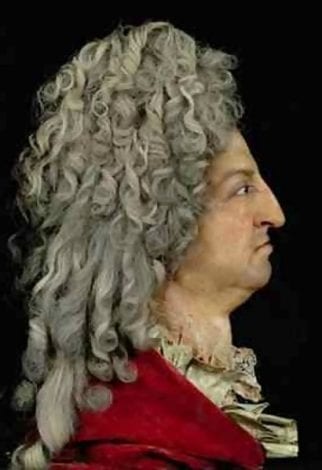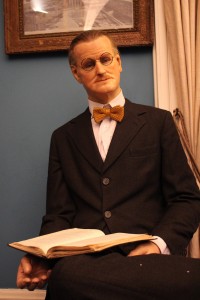
The Musee Conti, in New Orleans’ French Quarter, is filled with life-sized wax figures depicting vignettes from Louisiana history: Napoleon as he sells Louisiana, Jean Lafitte on his pirate ship, Andrew Jackson during the Battle of New Orleans, Marie Laveau with her voodoo dancers.
Unfortunately, after operating for more than 50 years, last week the museum closed without me ever getting a chance to visit. Since then I’ve done some research on the history of replicating dead—and still living—people in wax, putting clothes on them and displaying the figures for the public. Turns out the practice began in the Middle Ages. At royal funerals it was routine to carry the fully dressed corpse on top of the coffin. But in hot weather corpses tended to rot and the custom developed of making an effigy of the deceased in wax. After the funeral, these wax bodies were often displayed at the tomb or in a church and became popular attractions.

Antoine Benoist’s famed wax portrait of Louis XIV is on display at the Palace of Versailles. (via Google Cultural Institute)
Perhaps the most famous early creator of wax people was Antoine Benoist, a French painter and sculptor born in 1632. Benoist served as personal painter to King Louis XIV and became a favorite of the French royal court. After a stunning exhibition of 43 wax figurines representing members (living ones) of the court, displayed at his home in Paris, Benoist’s popularity exploded. In 1684, King James II of England invited him to visit London and create wax sculptures of him and his court. During his lifetime, Benoist produced at least 90 wax heads, including a bust of Suzanne Phélypeaux. This was “a rare example of a female portrait,” stated an article in The Art Tribune.
I am struck with the question: Do wax sculptures in their current form represent an artistic way to remember and honor the dead—and those that will eventually be dead—or are they an awkward human attempt at sculpting immortality and trying to deal with the hollowness of death? Even the idea of a wax figurine is waxy, an ultra-plasticized embodiment of people whose starry and well-tabloided lives are often absurdly plasticized, to begin with. I am reminded of a Digital Dying story I wrote some years back about a West Virginia couple that runs a home business that “through a time-consuming and bizarre process…draws the moisture out of people’s pets, preserving the animals indefinitely in predetermined positions.”
Anyway, here is Digital Dying’s list of the World’s Wax Museums. We begin with the obvious…

Hong Kong actress and cantopop singer Cecilia Cheung, one of many wax figures at the Madame Tussauds, in Shanghai, China.
Madame Tussauds – In 1835 Madame Tussaud set up an exhibition on London’s Baker Street, and thus was born the modern wax museum. Today the Madame has museums in the U.S., Europe, Asia and Australia. Their Wuhan, China museum, which opened in 2013 features Albert Einstein, Johnny Depp and the Chinese basketball sensation Yao Ming.
Louis Tussaud’s Waxworks – Located in San Antonio, Texas, Louis’s has Britney Spears, Frankenstein and, compulsory at virtually any wax museum, Superman. Louis has other waxworks on the Canadian side of Niagara Falls, and in Grand Prairie, Texas.
The Movieland Wax Museum – This Buena Park, California wax museum was long a favorite for travelers on the wax circuit, unfortunately the museum closed in 2005, citing decreased attendance. About 80 wax figures were shipped to a museum in South Korea, 50 went to a wax museum in San Francisco and many others were sold, including the Star Trek cast (it went to a fan for $34,000), Superman (sold for $16,000), Elvis ($14,000) and a gigantic statue of Michelangelo’s David that stood outside the museum: $120,000. The city of Buena Park plans to turn the building into a Butterfly Pavilion.
Hollywood Wax Museum – There are several, one is in Hollywood, but the far stranger one is in the lively country music town of Branson, Missouri. The museum underwent a multi-million dollar renovation in 2009 and now includes an animated ride and a mirror maze.

James Joyce is among the many notable Irish authors on display at the National Wax Museum in Dublin. (via waxmuseumplus.ie)
National Wax Museum, Dublin, Ireland – Here are great Irish writers like James Joyce, Samuel Beckett, Oscar Wilde and George Bernard Shaw as well as a “Chamber of Horror,” with Hannibal Lector and Dracula. The museum also allows visitors to create wax models of their own hands, and recently posted a Valentine’s Day special: “For just 40 Euros, you and your partner can take a tour of the museum, followed by getting a special couples Wax Hand to mark the occasion!”
Dreamland Wax Museum, Gramado, Brazil – I couldn’t find much on this museum, although it gets pretty good marks on TripAdvisor. “The place is a lot of fun,” wrote one reviewer. “Although some of the figures don’t look very much like the original people and some figures are very short.”
The National Presidential Wax Museum, Keystone, South Dakota – Located near Mount Rushmore and the Crazy Horse Memorial, there are wax models of all U.S. Presidents and many foreign leaders.
One place wax museums have really taken off is India. There’s the fancy new Mother’s Wax Museum, in Kolkata, featuring wax models of A.J.C. Bose, Diego Maradona, Amitabh Bachchan, Manna Dey and Mahatma Gandhi, the Melody World Wax Museum, in Mysore, a smaller more ramshackle museum that features wax statues and also musical instruments and The Celebrity Wax Museum, in Old Mumbai.

Figures of the US’s most storied historical leaders are on display throughout Potter’s Wax Museum. (via Roadside America)
Potter’s Wax Museum, St. Augustine, Florida – The gem of American wax museums, and the oldest, it was founded in 1948 by eccentric George Leonard Potter. After his mother, father and wife all died within a few years of each other, Potter indulged his fantasy and ordered hundreds of top-of-the-line custom-made wax dummies from London, and opened a wax museum in St. Augustine called Potter’s International Hall of Fame. The wax dummies were apparently flown across the Atlantic in airline seats. According to RoadsideAmerica, George, quite the enthusiast, wrote a 400-page guidebook detailing the history of every wax figure, and expected his tour guides to have it memorized. By the late 1970s Potter’s was the second largest wax museum in the world, but when George died his son began selling the dummies, having little interest in carrying on the family business. George’s sympathetic curator, Dottie White, bought 150 of the wax figures and reopened the museum in a much more cramped space, calling it Potter’s House of Wax. In 2014, the museum changed hands again, and moved to an authentic old drug store. The collection is expanding.
Back in New Orleans, plans already appear to be moving forward for the Musee Conti’s next incarnation, high-end condos. But of course.
And what about the wax figures?
“They’re certainly not getting thrown away,” developer Jonathan Weber told the Times-Picayune. “Those things are pretty unbelievable. Ideally, we’d like to keep them in use so people can still take a look at them.”
Even as the moment for wax may be moving on, we humans have an unceasing urge to preserve the moment.









